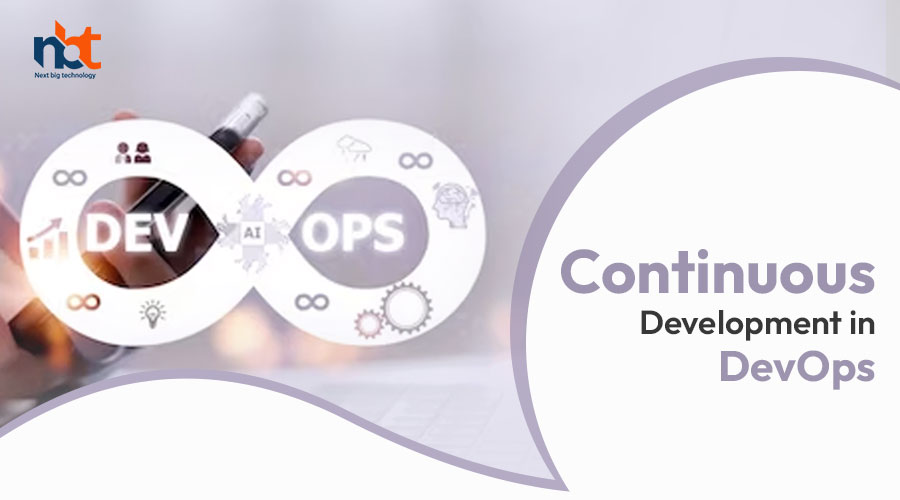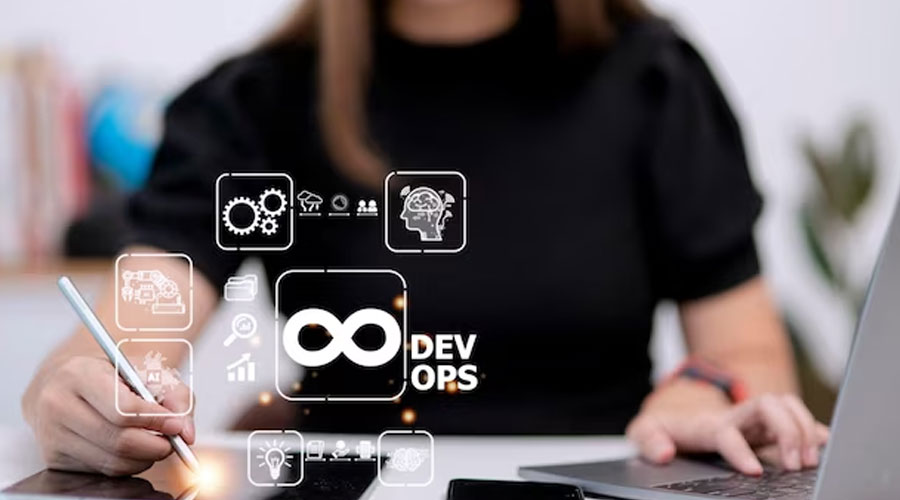Table of Contents
Continuous Development in DevOps Services
In the realm of software development, the landscape is continually evolving, and the emergence of DevOps services stands as a testament to this evolution. DevOps, an amalgamation of development and operations, has transformed the way software is built, tested, and deployed. However, its journey doesn’t end there. Continuous development in DevOps services is pushing boundaries, reshaping practices, and fostering innovation like never before.
Understanding Continuous Development in DevOps
Continuous Development (CD) in DevOps encapsulates the ethos of perpetual enhancement and iteration. It revolves around the idea of incessant improvement throughout the software development lifecycle. This iterative approach ensures that software is continually refined, delivering value to end-users efficiently and promptly.
Embracing Automation: Automation lies at the heart of continuous development in DevOps. It streamlines processes, reduces manual intervention, and enhances efficiency. From code compilation to testing and deployment, automation tools and practices enable teams to accelerate delivery timelines while maintaining quality standards.
Integration and Collaboration: CD in DevOps emphasizes seamless integration and collaboration among development, operations, and quality assurance teams. By breaking down silos and fostering cross-functional collaboration, organizations cultivate a culture of shared responsibility and collective ownership. This collaborative environment accelerates feedback loops, mitigates risks, and promotes innovation.
Feedback-driven Iteration: Continuous feedback is the cornerstone of CD in DevOps. By soliciting feedback from stakeholders and end-users early and frequently, teams gain valuable insights into user preferences, pain points, and emerging trends. This feedback loop empowers teams to adapt swiftly, iterate rapidly, and align product development with evolving market dynamics.
The Evolutionary Trajectory of DevOps Services
The evolution of DevOps services is marked by a series of paradigm shifts and technological advancements. From the rudimentary practices of manual deployment to the sophisticated automation frameworks of today, DevOps has traversed a remarkable trajectory of evolution.
DevOps 1.0: Foundation Building The inception of DevOps marked a paradigm shift in software development methodologies. DevOps 1.0 laid the foundation for collaboration between development and operations teams, emphasizing communication, shared goals, and cross-skilling. Tools like Puppet and Chef emerged to automate configuration management, paving the way for more streamlined workflows.
DevOps 2.0: Automation and Orchestration DevOps 2.0 witnessed the proliferation of automation and orchestration tools, revolutionizing deployment pipelines and release management. Technologies like Jenkins, Ansible, and Docker gained prominence, enabling organizations to achieve unprecedented levels of agility, scalability, and reliability. Infrastructure as Code (IaC) emerged as a best practice, facilitating the programmable provisioning and configuration of infrastructure resources.
DevOps 3.0: Shift-left and Continuous Everything DevOps 3.0 heralds the era of shift-left practices and “continuous everything.” This phase emphasizes shifting quality assurance and security processes earlier into the software development lifecycle. Practices like Continuous Integration (CI), Continuous Delivery (CD), and Continuous Deployment (CD) become ingrained in organizational culture, enabling rapid iteration, frequent releases, and real-time feedback loops.
Embracing the Future: Trends Shaping Continuous Development in DevOps
As DevOps continues to evolve, several trends are shaping the trajectory of continuous development:
DevSecOps: Integrating Security into DevOps DevSecOps emphasizes the integration of security practices into the DevOps pipeline, fostering a culture of shared responsibility for security. By embedding security controls and compliance measures early into the development process, organizations can proactively mitigate security risks and vulnerabilities.
Site Reliability Engineering (SRE): Ensuring Resilience and Scalability SRE blends software engineering principles with operational excellence to ensure the reliability, resilience, and scalability of systems. By implementing SRE practices, organizations can proactively monitor, troubleshoot, and optimize their infrastructure, minimizing downtime and enhancing user experience.
AI and Machine Learning in DevOps: AI and machine learning are poised to revolutionize DevOps practices, enabling predictive analytics, anomaly detection, and intelligent automation. By leveraging AI-driven insights, organizations can optimize resource utilization, enhance performance, and preemptively address potential issues before they escalate.
How to Create a Continuous Development in DevOps
In today’s rapidly evolving digital landscape, DevOps has emerged as a crucial methodology for software development and deployment. One of the core principles of DevOps is continuous development, which ensures that teams can deliver high-quality software at a rapid pace while maintaining efficiency and reliability. In this guide, we’ll explore how to establish and nurture a culture of continuous development within your DevOps environment.
Understanding Continuous Development
Continuous development in DevOps revolves around the idea of constantly improving and enhancing software through iterative processes. It involves automating the development pipeline to enable seamless integration, testing, and deployment of code changes. By breaking down silos between development and operations teams, continuous development fosters collaboration and accelerates the delivery of features and updates to end-users.
Key Components of Continuous Development
- Automation: Automation lies at the heart of continuous development. By automating repetitive tasks such as code compilation, testing, and deployment, teams can significantly reduce the time taken to deliver new features or fixes. Utilize tools like Jenkins, Travis CI, or GitLab CI/CD to automate your development pipeline.
- Continuous Integration (CI): CI involves regularly merging code changes into a shared repository, followed by automated builds and tests. This practice ensures that code changes are validated early and frequently, reducing the likelihood of integration issues down the line. Integrate CI tools seamlessly into your workflow to streamline the development process.
- Continuous Delivery (CD): CD extends the concept of CI by automatically deploying code changes to production or staging environments after passing through the necessary tests. Implement robust deployment pipelines using tools like Kubernetes, Docker, or AWS CodeDeploy to achieve seamless and reliable deployments.
- Feedback Loops: Continuous development relies on timely feedback to identify areas for improvement and address issues promptly. Encourage open communication channels between development, operations, and quality assurance teams to facilitate rapid feedback loops. Leverage monitoring and logging tools to gain insights into application performance and user behavior.
- Iterative Improvement: Embrace an iterative approach to development by continuously refining processes, tools, and practices. Encourage experimentation and learning within your team to drive innovation and adaptation to changing requirements. Foster a culture of continuous learning and improvement to stay ahead in the ever-evolving tech landscape.
Best Practices for Implementing Continuous Development
- Define Clear Goals: Establish clear objectives for your continuous development efforts, aligning them with business goals and customer needs. Set measurable key performance indicators (KPIs) to track progress and ensure accountability.
- Standardize Processes: Standardize development, testing, and deployment processes across teams to promote consistency and efficiency. Document workflows and best practices to facilitate knowledge sharing and onboarding of new team members.
- Invest in Training: Invest in training and upskilling your team members to ensure they have the necessary skills and expertise to effectively leverage DevOps practices. Provide access to resources and certifications to support continuous learning.
- Encourage Collaboration: Foster a collaborative culture where developers, operations engineers, and other stakeholders work together towards common objectives. Break down organizational silos and promote cross-functional teams to facilitate communication and collaboration.
- Embrace Automation: Automate repetitive tasks wherever possible to reduce manual effort and minimize the risk of human error. Invest in robust automation tools and frameworks to streamline your development pipeline and accelerate delivery cycles.
Why Should You Go for Continuous Development in DevOps?
In today’s fast-paced digital landscape, businesses are constantly seeking ways to deliver high-quality software at an accelerated pace. This is where DevOps comes into play, revolutionizing the traditional software development and deployment processes. At the heart of DevOps lies the principle of continuous development, a methodology that emphasizes constant iteration, improvement, and collaboration between development and operations teams. But why exactly should you embrace continuous development in DevOps? Let’s delve deeper into the reasons behind its importance.
- Rapid Adaptation to Market Changes: In a dynamic market environment, the ability to swiftly respond to changing customer needs and market trends is paramount. Continuous development enables organizations to adapt their software products in real-time, ensuring that they remain competitive and relevant in the face of evolving market demands.
- Faster Time-to-Market: Time is of the essence in today’s digital economy. Continuous development streamlines the software delivery pipeline, allowing for the rapid release of new features and updates. This accelerated time-to-market not only enhances customer satisfaction but also provides businesses with a competitive edge by enabling them to seize market opportunities more effectively.
- Improved Software Quality: By breaking down development into smaller, manageable increments and incorporating automated testing and feedback loops, continuous development promotes the early detection and resolution of bugs and issues. This results in higher software quality, reducing the likelihood of costly errors and downtime down the line.
- Enhanced Collaboration and Communication: DevOps is founded on the principles of collaboration and communication between development, operations, and other cross-functional teams. Continuous development fosters a culture of collaboration by encouraging regular interaction and feedback exchange, breaking down silos, and promoting a shared sense of responsibility for the software delivery process.
- Optimized Resource Utilization: Continuous development minimizes waste by focusing on delivering value in small, iterative increments. This iterative approach allows organizations to optimize resource utilization, allocate resources more efficiently, and prioritize tasks based on business value, thereby maximizing return on investment (ROI) and minimizing overhead costs.
- Continuous Improvement: Continuous development is not just about delivering software faster; it’s also about continuously improving processes and practices over time. By embracing a culture of experimentation, learning, and adaptation, organizations can foster innovation and drive continuous improvement across all aspects of their software delivery pipeline.
- Enhanced Risk Management: Traditional waterfall development methodologies often entail significant risks associated with large-scale releases and lengthy development cycles. Continuous development mitigates these risks by enabling organizations to release small, incremental changes more frequently, thereby reducing the scope and impact of potential failures.
- Increased Customer Satisfaction: Ultimately, the goal of continuous development is to deliver value to customers more effectively and efficiently. By continuously incorporating customer feedback and iterating on product features, organizations can ensure that their software products meet the evolving needs and expectations of their customers, leading to higher levels of satisfaction and loyalty.
Essential Features of a Continuous Development in DevOps
In the fast-paced world of software development, embracing DevOps methodologies has become essential for organizations striving to stay competitive. At the heart of DevOps lies continuous development, a practice that ensures seamless integration, testing, and deployment of code. To achieve true agility and efficiency, it’s crucial to understand the essential features that drive continuous development in DevOps. Let’s delve into these key elements:
- Automation: Automation lies at the core of continuous development. By automating repetitive tasks such as testing, code integration, and deployment, teams can accelerate the development cycle and reduce human error. Tools like Jenkins, GitLab CI, and Travis CI facilitate automation, enabling seamless integration of code changes and continuous delivery.
- Collaboration: Effective collaboration between development, operations, and quality assurance teams is vital for successful continuous development. Adopting collaborative tools like Slack, Microsoft Teams, or Atlassian’s Jira fosters communication and transparency across departments, ensuring everyone is aligned towards common goals.
- Version Control: Version control systems such as Git play a pivotal role in continuous development by enabling teams to manage changes to source code efficiently. By maintaining a centralized repository of code and tracking modifications, teams can easily collaborate, revert to previous versions if needed, and maintain a clear audit trail of changes.
- Infrastructure as Code (IaC): IaC allows teams to manage and provision infrastructure using code, thereby streamlining the deployment process and ensuring consistency across environments. Tools like Terraform and AWS CloudFormation enable teams to define infrastructure requirements declaratively, reducing manual intervention and minimizing configuration drift.
- Continuous Integration (CI): CI practices involve regularly integrating code changes into a shared repository, followed by automated testing to detect integration errors early. CI pipelines, configured using tools like Jenkins or CircleCI, automate the build, test, and validation processes, enabling teams to identify and fix issues quickly, thereby maintaining code quality.
- Continuous Deployment (CD): CD extends CI by automating the deployment of code changes to production environments once they pass the necessary tests. By implementing CD pipelines with tools like Spinnaker or GitLab CI/CD, teams can achieve rapid and reliable deployment, reducing time-to-market and enhancing overall efficiency.
- Monitoring and Feedback: Continuous development is incomplete without robust monitoring and feedback mechanisms. Utilizing tools like Prometheus, Grafana, or New Relic allows teams to monitor application performance, detect anomalies, and gather feedback from users, enabling iterative improvements and informed decision-making.
- Security: Integrating security into every stage of the development lifecycle is crucial for maintaining the integrity and resilience of software systems. Implementing security testing tools such as SonarQube or Veracode, along with practices like static code analysis and vulnerability scanning, helps identify and remediate security threats proactively.
Advanced Features Continuous Development in DevOps
In the ever-evolving landscape of software development, DevOps continues to stand out as a transformative approach that bridges the gap between development and operations teams. With its focus on collaboration, automation, and continuous improvement, DevOps has become the cornerstone of modern software delivery practices. However, as technology advances and market demands evolve, the realm of DevOps also undergoes continuous development to meet new challenges and enhance efficiency. In this article, we’ll delve into the advanced features and ongoing developments in DevOps that are shaping the future of software delivery.
Embracing Infrastructure as Code (IaC): One of the key advancements in DevOps is the widespread adoption of Infrastructure as Code (IaC). This practice involves managing and provisioning infrastructure through code and configuration files, enabling teams to automate infrastructure deployment and configuration. By treating infrastructure as code, organizations can achieve consistency, repeatability, and scalability in their environments. Tools like Terraform, Ansible, and Chef empower DevOps teams to define infrastructure requirements declaratively, leading to faster provisioning, reduced errors, and increased agility.
Shift Left Security: Security has always been a critical concern in software development, and DevOps brings it into focus with the concept of “shift left.” Traditionally, security measures were implemented late in the development lifecycle, leading to potential vulnerabilities and delays in addressing security issues. However, with shift-left security, security considerations are integrated earlier into the development process, starting from the planning and design phases. By incorporating security testing, code analysis, and compliance checks into automated pipelines, DevOps teams can proactively identify and mitigate security risks, ensuring that security is not an afterthought but an integral part of the development process.
Continuous Integration/Continuous Deployment (CI/CD) Pipelines: CI/CD pipelines lie at the heart of DevOps practices, enabling teams to automate the build, test, and deployment processes. Advanced CI/CD pipelines incorporate features such as parallel testing, canary releases, and blue-green deployments to streamline the delivery pipeline and minimize downtime. With the rise of microservices architectures and containerization technologies like Docker and Kubernetes, CI/CD pipelines have become more sophisticated, supporting complex deployment scenarios and enabling rapid iteration and delivery of software updates.
Observability and Monitoring: In a distributed and dynamic environment, observability plays a crucial role in ensuring the reliability and performance of applications. DevOps teams leverage advanced monitoring tools and practices to gain insights into system behavior, detect anomalies, and troubleshoot issues in real-time. Techniques like distributed tracing, centralized logging, and metrics aggregation provide visibility into application performance across the entire stack, empowering teams to proactively identify and address potential bottlenecks and failures before they impact end-users.
AI and Machine Learning in DevOps: The integration of artificial intelligence (AI) and machine learning (ML) technologies is revolutionizing DevOps practices, enabling predictive analytics, automated anomaly detection, and intelligent decision-making. AI-powered tools can analyze vast amounts of data from monitoring systems, source code repositories, and deployment pipelines to identify patterns, predict failures, and optimize resource utilization. By harnessing the power of AI and ML, DevOps teams can enhance productivity, reduce operational overhead, and deliver more reliable and resilient software solutions.
























